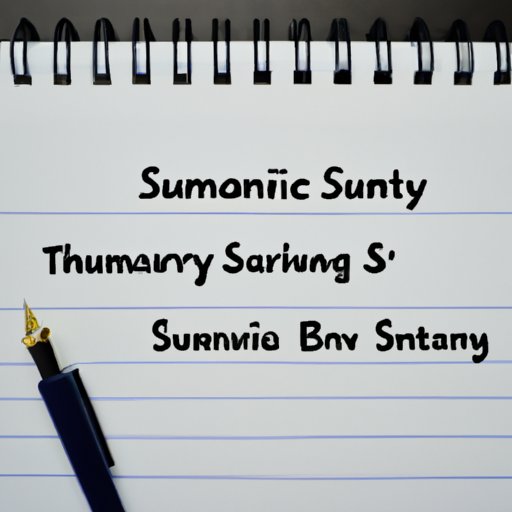
I. Introduction
Writing a summary can be a challenging task, especially when you’re trying to capture the essence of a lengthy piece in only a few paragraphs. One of the most important aspects of a summary is its introduction, which sets the tone for the rest of the piece. In this article, we’ll explore best practices for starting a summary, including tips for drafting a strong opening sentence. We’ll also discuss common mistakes to avoid, so you can make the most out of your next summary.
II. Understanding a Summary
Before we dive into best practices, it’s important to understand what a summary is and how to identify a good one. A summary is a condensed version of a longer document or article, highlighting the most important points and leaving out extraneous information. Ideally, a summary should convey the essence of the original piece while remaining concise and easy to read.
What makes a good summary? First and foremost, it should accurately reflect the author’s intended meaning. It should also be brief, well-organized, and easy to understand. Finally, a good summary should be engaging and capture the reader’s interest from the first sentence.
As you can see, the introduction is key to a successful summary. Without a strong first sentence, readers may lose interest before reaching the meat of your piece. So how can you ensure that your summary introduction is as engaging as possible?
III. Best Practices for Starting a Summary
Effective summary writing requires preparation and planning. Before you start writing the introduction, take some time to re-read the original piece and identify its main points. Jot down a few notes about the most important information and how it relates to each other. This will help you organize your thoughts and keep your summary focused.
When crafting your introduction, there are a few best practices to keep in mind:
- Start with a hook. The first sentence of your summary should be attention-grabbing and leave the reader intrigued. This could be a surprising fact, a provocative statement, or a relevant quote. Here’s an example: “In today’s fast-paced world, time management is more crucial than ever. This article explores top tips for improving your productivity and making the most out of your day.”
- Be concise and clear. Remember, your summary should be brief and to the point. Avoid flowery language and focus on conveying the most important information as clearly as possible.
- Use transitions. As you move from your introduction to the body of your summary, use transitions to help your reader follow your train of thought. This could be done by using phrases like “In conclusion” or “Additionally.”
Of course, there’s no one right way to start a summary. Here are a few alternative approaches you could try:
- Start with a question. This can be an effective way to pique the reader’s curiosity and engage them in your summary. For example: “What if I told you there was a way to double your productivity in half the time?”
- Start with a definition. If your topic is complex or technical, you might consider defining key terms right off the bat. For example: “When we talk about ‘climate change,’ what do we really mean?”
Ultimately, the best approach will depend on your topic and audience. The most important thing is to ensure that your introduction is engaging and accurately reflects the tone and content of your summary.
IV. Common Mistakes to Avoid
While there are many best practices to follow when starting a summary, there are also a few common mistakes to avoid. These include:
- Copying the original text too closely. Remember, your summary should be your own work, not a copy-paste of the original piece. Use your own words and add your own analysis and insight as appropriate.
- Omitting key information. While it’s important to be concise, don’t leave out critical information that your reader needs to understand the original piece. Make sure your summary covers all the essential points.
- Being too vague. While you don’t want to go into excessive detail, your summary should convey enough information to give the reader a clear idea of what the original piece is about. Avoid overly broad statements that don’t provide enough context.
- Starting with a long, convoluted sentence. It can be tempting to show off your writing chops by beginning with a complex sentence, but this can backfire if your reader gets lost in the verbiage. Stick to simple, clear sentences that are easy to follow.
Avoiding these mistakes is crucial to ensuring that your summary is effective and engaging. By taking the time to plan and draft your introduction carefully, you can avoid these pitfalls and start your summary on the right note.
V. Conclusion
Writing an effective summary is a valuable skill for students, researchers, and professionals alike. By following best practices for starting your introduction, you can capture readers’ attention and set the stage for a successful summary. Remember to take the time to plan and organize your thoughts before starting to write, and avoid common mistakes like being too vague or copying the original text too closely. With these tips in mind, you’ll be well on your way to writing summaries that are engaging, informative, and effective.





